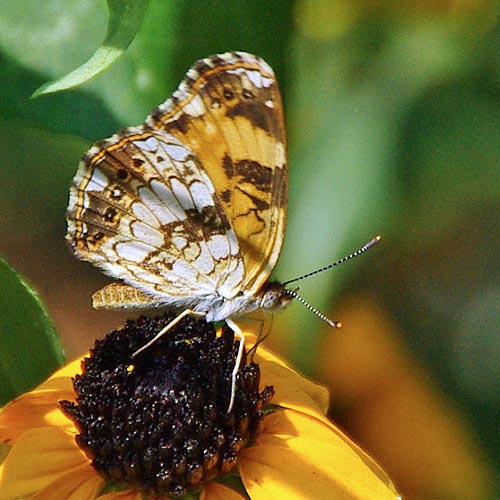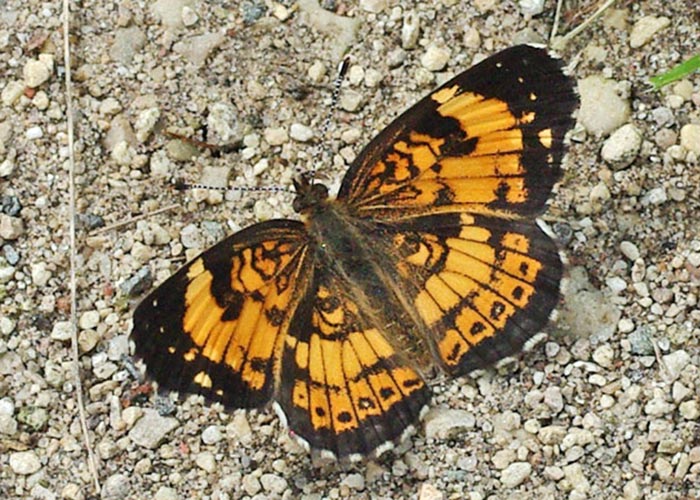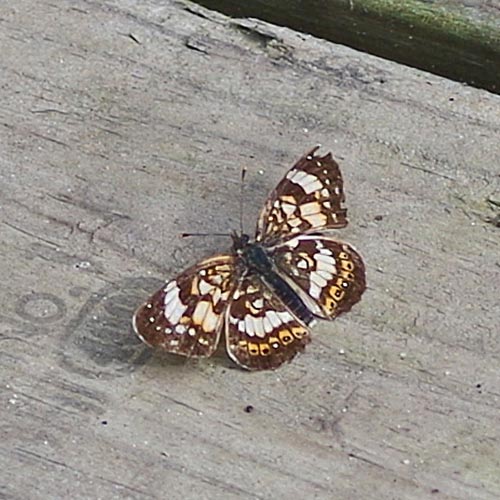Salutations, BugFans,
When the BugLady started writing this episode, she thought she had two species of checkerspots to share, the Gorgone and the Silvery. Further research left her scratching her head. Thanks to BugFan Mike for helping her avoid one of those “publish in haste, repent at leisure” moments (any mistakes are her own).
Silvery Checkerspot
Silvery Checkerspots are in the brushfoot family Nymphalidae, which is the biggest butterfly family with about 6,000 species (209 in North America, says bugguide.net. Other brushfoots include familiar species like monarchs, admirals, fritillaries, commas/anglewings, buckeyes, and browns/satyrs. They are generally medium to large, colorful creatures, but many have camouflaged underwings. Their caterpillars often sport spines for protection (some have wicked-looking branched spines). “Brushfoot” comes from the fact that you’d have to squint pretty hard to count the normal complement of insect legs (six) on these butterflies. The front pair has been modified into two hairy, bottle-brush-like appendages that cannot be used for walking, so the adults look and walk four-legged. Depending on whose book you read, the brushes are useless; or they are useless in males but sensory in females, used by her to taste/smell a leaf in order to verify its identification as her caterpillar’s food plant before she oviposits.

The Silvery Checkerspot (Chlosyne nycteis) has a bunch of aliases like Nycteis Crescent, Silvery Crescent, Streamside Checkerspot and Sunflower Checkerspot. The Silvery Checkerspot is sometimes called Crescentspot, because of crescent-shaped wing markings that resemble the markings of the common Northern and Pearl Crescents, also pictured here.
[metaslider id=1965]
As the common name Streamside Checkerspot suggests, this species likes damp meadows, marshes, roadsides, open woods and stream edges, but it also likes areas of disturbed, poor, or sandy soil. It’s found from southern Canada through the Great Plains to Texas and east to the Atlantic, with the exception of the Southeastern Coastal Plains. Like other checkerspots, its populations can vary wildly from year to year, and it may disappear from a breeding area for decades. A note from Point Pelee, Ontario, saying that SCs were not recorded there between 1928 and 1982 but popped up again in 1987, is typical.
The SC was named for the bands of silvery patches and spots on its underwings. Males are darker than females. In her research about the SC, the BugLady kept reading about the other butterflies that could be mistaken for it, so she decided to check her crescent pictures to see if she had slipped up. She had. Note to self—not all Pearl Crescents are. SCs are a bit larger than the Crescents (1 ½” to 2” wingspreads to the Crescents’ 1” to 1 ½”). As Mike Reese says on the Wisconsin Butterflies site, “This species is fairly easy to identify when it is fresh and you can see the underside, but it wears more than other butterflies, tends to look very plain, and loses it contrast, as it gets older.” See the Bug Life Cycle website for baby pictures.

Males like to perch, and they also patrol a territory for females. Eggs are laid on the undersides of leaves in clusters of as many as 100. The caterpillars feed communally, starting with the underside of the leaf and skeletonizing it (eating all of the leaf but its veins). They overwinter/aestivate as half-grown caterpillars and mature the next spring. There are two – or more – broods per year in more southern parts of their range.
Caterpillar host plants include asters, coneflowers, and sunflowers. Sunflower Checkerspot. In more southerly climes where there are two or more generations a year (think Kansas), caterpillars of the later generations can eat a substantial number of leaves of commercial sunflowers and will head off cross country to find another host plant when they’ve stripped their natal plant.

Adult SCs are found nectaring on flowers, and they visit mud puddles and damp road edges for minerals. They tend to sit with their wings folded, but they bask with wings open (dorsal basking) (in order for wing muscles to work efficiently, the internal temperature of the thorax must be at least 80 degrees F). Adults are very short-lived, lasting only about two weeks.
The BugLady stumbled across Butterfly Nature and enjoyed looking around in it.
The Bug Lady